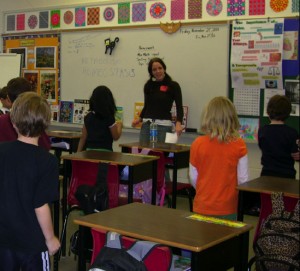Polymers
May 2, 2012 in Polymers
On Friday, December 2nd, 2011, the 3rd and 4th grade students in Ms. Tanya Steinberg’s class at St. John Bosco School linked together to mimic a polymer chain as they learned about macromolecules, thanks to the team of Amber Stevens (B.A. Studio Arts, Concordia U.) and and Robert Hopewell (M.Sc. Chemistry, U. Montréal). Amber and Robert first explained that polymers are formed by the joining together of smaller molecular units called monomers and that there are both natural and synthetic (human-made) polymers. The students were then given a variety of cards containing samples of various polymers (i.e. nylon, rayon, silk, cellulose, wool…) and asked if they thought they could guess the polymer and if it was natural or synthetic. The students were then asked to identify things made of polymers around the classroom, such as the their wooden desks, papers and cotton T-shirts, all made from the polymer cellulose, which is a chain of sugar monomers. The students made next their own polymer chain by linking their arms together. As their chain wrapped upon itself, the students were asked to imagine the ways polymers could naturally fold together and become entangled.
Exploring a synthetic polymer more closely, the students watched as Robert dissolved polystyrene foam (styrofoam) cups into acetone (nail polish remover) releasing the trapped air in the foam to produce a sticky goo of polystyrene. Examining samples after various stages of drying, the students recognized that the polystyrene could be stretched and molded until it dried into a brittle plastic, which is commonly used to manufacture various things such as CD cases, disposable razors and smoke detector housings.
Experiencing the organized entanglement of polymer chains, the students were taught by Amber how to weave baskets using yarn and paper. Note, yarn may be made from various natural and synthetic polymers such as sheep wool, which is made from a natural protein polymer called keratin, a key component of hair. Wrapping natural wool polymers around to make baskets, the students were exposed to one of the most important crafts in the history of human civilization.
Making cross-links from their experiences in the identification, formation, properties and uses of polymers, the students thanked team polymer for enwrapping them in the magic of Molecules of Life.
For more on the Foam Cup Meltdown see http://tlc.howstuffworks.com/family/science-projects-for-kids-chemical-reactions1.htm








